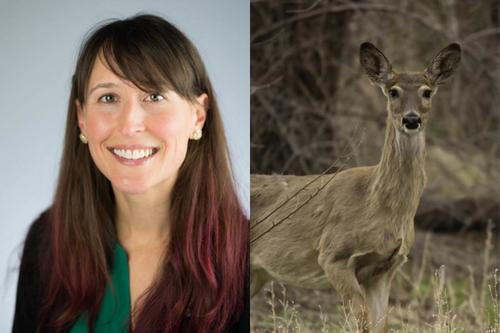
Chronic Wasting Disease (CWD), a neurodegenerative disease, is spreading within the state’s whitetail deer population.
Tiffany Wolf with the University of Minnesota College of Veterinary Medicine answers questions about what CWD is, where it is found and precautions that should be taken when eating venison.
Q: What is CWD?
Prof. Wolf: CWD is a contagious and 100 percent fatal neurodegenerative disease of cervids, such as deer, moose, elk, caribou and reindeer. When deer become infected with the CWD-causing prion protein, it causes other normal prion proteins within the nervous system to behave unnaturally. CWD belongs to a family of well-known prion diseases. Infected deer exhibit abnormal behavior, including decreased interaction with other deer, loss of awareness, loss of fear of humans; excessive drinking, urination or salivation; and, most commonly, progressive weight loss. Infected deer can transmit CWD for up to two years before they ever show clinical signs or die from the disease.
Q: Where has CWD been found and how has it spread?
Prof. Wolf: CWD likely originated in Colorado in the 1960s and has since spread to 26 U.S. states in both wild and farmed cervids. This CWD-causing prion is spread by both animal-to-animal and environment-to-animal contact. Infected animals can begin shedding these prions into the environment soon after infection through saliva, blood, feces and urine. They can serve as a source of infectious prions for up to 88% of their infected life. Their carcasses can also serve as a source of new CWD infections. One of the most challenging aspects of managing CWD is that the infectious prions can survive for years within the environment. The disease progresses slowly. Since infected animals can go months before displaying obvious symptoms, control strategies are difficult to execute. In Minnesota, the disease has been found in wild white-tailed deer as well as in elk, mule deer, and white-tailed deer on cervid farms.
Q: How can hunters help prevent further spread of CWD?
Prof. Wolf: There are some clear guidelines, based on what is known about transmission, that help eliminate practices that contribute to CWD spread. The Minnesota Department of Natural Resources (DNR) has adopted them as part of a comprehensive approach to controlling the disease in Minnesota, which restricts the movement of deer carcasses and bans the use of products and feed that bait or unnaturally congregate animals, particularly in areas where CWD has been found. If a hunter observes an unhealthy deer anywhere, they should report it to DNR managers. For more specific information on regulations pertaining to CWD control, hunters should visit the DNR’s website.
Q: What precautions should be taken when eating venison or other cervid meat?
Prof. Wolf: Currently, there is no published data that demonstrates CWD can infect humans. However, we do not yet fully understand the risk CWD poses to humans, so the Centers for Disease Control and Prevention (CDC) recommends that we do not eat CWD contaminated meat. To be as safe as possible, hunters should familiarize themselves with CWD positive areas and avoid consuming meat from deer that appear unhealthy. However, CWD positive animals might not look sick because the disease has a very slow progression. This is why CWD testing is strongly recommended in all harvested deer (healthy looking or otherwise) in CWD-positive areas. For more specific information regarding CWD testing, hunters should visit the DNR’s website.
Q: What is the University of Minnesota doing to slow the spread of CWD?
Prof. Wolf: First, we are working with several Minnesota agencies to facilitate surveillance and enhance our understanding of risk for spread. These partners include the DNR, Minnesota Board of Animal Health, as well as several Tribal natural resources agencies around the state. Thanks to funding from the Minnesota Legislature, the University’s College of Veterinary Medicine has assembled a multi-disciplinary team of scientists to develop new CWD diagnostic tools as well as enhance CWD outreach among diverse Minnesota hunting communities. Current CWD diagnostic tests are limited for many reasons. The development of rapid diagnostic tests will improve disease detection among harvested animals and reshape how we study the transmission of this disease between animals and the environment. Additionally, our team is connecting with the public through extensive outreach that includes Minnesota Legislature funded research to understand cultural perspectives and knowledge of CWD and management. The bottom line is that slowing the spread of CWD will require a coordinated effort of all stakeholders across the state and region, and the University of Minnesota is committed to that effort.
Tiffany Wolf is an assistant professor in the University of Minnesota College of Veterinary Medicine. Her areas of expertise include infectious disease ecology, veterinary public health and ecosystem health.
-30-
About “Talking...with U of M”
“Talking...with U of M” is a resource whereby University of Minnesota faculty answer questions on current and other topics of general interest. Feel free to republish this content. If you would like to schedule an interview with the faculty member or have topics you’d like the University of Minnesota to explore for future “Talking...with U of M,” please contact University Public Relations at [email protected].
- Categories:
- Health




